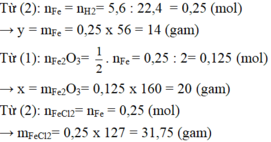Hãy nhập câu hỏi của bạn vào đây, nếu là tài khoản VIP, bạn sẽ được ưu tiên trả lời.

\(a,PTHH:4Al+3O_2\underrightarrow{t^o}2Al_2O_3\\ n_{Al}=\dfrac{m}{M}=\dfrac{10,8}{27}=0,4\left(mol\right)\\ Theo.PTHH:n_{Al_2O_3}=\dfrac{1}{2}.n_{Al}=\dfrac{1}{2}.0,4=0,2\left(mol\right)\\ m_{Al_2O_3}=n.M=0,2.102=20,4\left(g\right)\)
\(b,n_{O_2}=\dfrac{V_{\left(đktc\right)}}{22,4}=\dfrac{3,36}{22,4}=0,15\left(mol\right)\\ Lập.tỉ.lệ:\dfrac{n_{Al}}{4}>\dfrac{n_{O_2}}{3}\Rightarrow Al.dư\\ Theo.PTHH:n_{Al\left(pư\right)}=\dfrac{4}{3}.n_{O_2}=\dfrac{4}{3}.0,2\left(mol\right)\\ n_{Al\left(dư\right)}=n_{Al\left(bđ\right)}-n_{Al\left(pư\right)}=0,4-0,2=0,2\left(mol\right)\\ Theo.PTHH:n_{Al_2O_3}=\dfrac{1}{2}.n_{Al}=\dfrac{1}{2}.0,2=0,1\left(mol\right)\\ m_{Al_2O_3}=n.M=0,1=102=10,2\left(g\right)\)

Fe+2HCl->FeCl2+H2
0,1---------------------0,1
2H2+O2-to>2H2O
0,1----0,05 mol
0,1--0,1
n Fe=\(\dfrac{5,6}{56}\)=0,1 mol
=>VH2=0,1.22,4=2,24l
=>mkk=0,05.29=1,45l

a) Mg + 2HCl \(\rightarrow\) MgCl2 + H2
Muối tạo thành: magie clorua
b) nMg = 8,4 : 24 = 0,35 mol
Theo pt: nH2 = nMg = 0,35 mol
=> V = 0,35 . 22,4 = 7,84l
c) Pt: 2Mg + O2 \(\xrightarrow[]{t^o}\) 2MgO
nO2 = 2,24 : 22,4 = 0,1 mol
Có nFe : nO2 = \(\dfrac{0,35}{2}:\dfrac{0,1}{1}=0,175:0,1\)
Do 0,175 > 0,1 nên Mg dư
nMg = 8.4 / 24 = 0.35 (mol)
Mg + 2HCl => MgCl2 + H2
0.35....................0.35....0.35
VH2 = 0.35 * 22.4 = 7.84 (g)
mMgCl2 = 0.35 * 95 = 33.25 (g)
nO2= 2.24 / 22.4 = 0.1 (mol)
2Mg + O2 -to-> 2MgO
2...........1
0.35......0.1
LTL: 0.35/2 > 0.1
=> Mg dư
Mg không cháy hết

a) \(n_{H_2}=\dfrac{13,44}{22,4}=0,6\left(mol\right)\)
PTHH: 2Al + 6HCl ---> 2AlCl3 + 3H2
Theo PTHH: \(n_{AlCl_3}=n_{Al}=\dfrac{2}{3}.n_{H_2}=\dfrac{2}{3}.0,6=0,4\left(mol\right)\)
=> mAl = 0,4.27 = 10,8 (g)
b) \(m_{AlCl_3}=0,4.133,5=53,4\left(g\right)\)

a, \(n_{H_2}=\dfrac{13,44}{22,4}=0,6\left(mol\right)\)
PT: \(Fe+2HCl\rightarrow FeCl_2+H_2\)
Theo PT: \(n_{HCl}=2n_{H_2}=1,2\left(mol\right)\Rightarrow m_{HCl}=1,2.36,5=43,8\left(g\right)\)
\(n_{Fe}=n_{H_2}=0,6\left(mol\right)\Rightarrow m_{Fe}=0,6.56=33,6\left(g\right)\)
c, \(n_{CuO}=\dfrac{16}{80}=0,2\left(mol\right)\)
PT: \(CuO+H_2\underrightarrow{t^o}Cu+H_2O\)
Xét tỉ lệ: \(\dfrac{0,2}{1}< \dfrac{0,6}{1}\), ta được CuO pư hết.
a, nH2 = V/22,4 = 13,44/22,4 =0.6 (mol)
Fe + 2HCl \(\rightarrow \) FeCl2 + H2
TLM : 1 2 1 1
Đề cho: 0,6<--1,2<----------- 0,6 (mol)
mHCl = n . M = 1,2 . 36,5 = 43,8 (g)
mFe= n . M = 0,6 . 56 =33,6 (g)
c, nCuO = \(\dfrac{16}{80}\)= 0,2 (mol)
CuO + H2 \(\rightarrow \) Cu + H2O
TLM: 1 1 1 1
Vì \(\dfrac{nH_2}{1}\)= 0,6 < \(\dfrac{n_{CuO}}{1}\)= 0.2
=> CuO phản ứng hết.

Câu 8:
Ta có: \(n_{H_2}=\dfrac{2,24}{22,4}=0,1\left(mol\right)\)
\(n_{O_2}=\dfrac{4,48}{22,4}=0,2\left(mol\right)\)
PT: \(2H_2+O_2\underrightarrow{t^o}2H_2O\)
Xét tỉ lệ: \(\dfrac{0,1}{2}< \dfrac{0,2}{1}\), ta được O2 dư.
Theo PT: \(\left\{{}\begin{matrix}n_{O_2\left(pư\right)}=\dfrac{1}{2}n_{H_2}=0,05\left(mol\right)\\n_{H_2O}=n_{H_2}=0,1\left(mol\right)\end{matrix}\right.\)
\(\Rightarrow n_{O_2\left(dư\right)}=0,15\left(mol\right)\)
\(\Rightarrow V_{O_2\left(dư\right)}=0,15.22,4=3,36\left(l\right)\)
\(m_{H_2O}=0,1.18=1,8\left(g\right)\)
Bạn tham khảo nhé!
Câu 9:
a, PT: \(2R+O_2\underrightarrow{t^o}2RO\)
Theo ĐLBT KL, có: mR + mO2 = mRO
⇒ mO2 = 4,8 (g)
\(\Rightarrow n_{O_2}=\dfrac{4,8}{32}=0,15\left(mol\right)\)
\(\Rightarrow V_{O_2}=0,15.22,4=3,36\left(l\right)\)
b, Theo PT: \(n_R=2n_{O_2}=0,3\left(mol\right)\)
\(\Rightarrow M_R=\dfrac{19,2}{0,3}=64\left(g/mol\right)\)
Vậy: M là đồng (Cu).
Câu 10:
Ta có: mBaCl2 = 200.15% = 30 (g)
a, m dd = 200 + 100 = 300 (g)
\(\Rightarrow C\%_{BaCl_2}=\dfrac{30}{300}.100\%=10\%\)
⇒ Nồng độ dung dịch giảm 5%
b, Ta có: \(C\%_{BaCl_2}=\dfrac{30}{150}.100\%=20\%\)
⇒ Nồng độ dung dịch tăng 5%.
Bạn tham khảo nhé!


